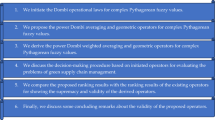Abstract
Neutrosophic numbers are very suitable for expressing indeterminate evaluation information in complex decision-making problems, and then projection measure is a useful method for handling the decision-making problems. However, due to the lack of engineering applications of neutrosophic numbers and some shortcoming implied in general projection measures in some cases. Therefore, the paper proposes a bidirectional projection measure of interval numbers to overcome the shortcoming and extend it to the bidirectional projection measure of neutrosophic numbers, and then develops a bidirectional projection-based multiple attribute group decision-making method with neutrosophic numbers. Through the bidirectional projection measure between each alternative decision matrix and the ideal alternative matrix, all the alternatives can be ranked to select the best one. Finally, an illustrative example demonstrates the application of the proposed method. The effectiveness and advantages of the proposed method are shown by the comparative analysis with existing relative methods.
Similar content being viewed by others
References
Xu ZS, Da QL (2004) Projection method for uncertain multi-attribute decision making with preference information on alternatives. Int J Inf Technol Decis Mak 3(3):429–434
Xu Z (2005) On method for uncertain multiple attribute decision making problems with uncertain multiplicative preference information on alternatives. Fuzzy Optim Decis Mak 4(2):131–139
Xu Z, Hu H (2010) Projection models for intuitionistic fuzzy multiple attribute decision making. Int J Inf Technol Decis Mak 9(2):267–280
Fu C, Gao X, Liu M, Liu XY, Han LS, Chen J (2011) GRAP: grey risk assessment based on projection in ad hoc networks. J Parallel Distrib Comput 71(9):1249–1260
Zheng G, Jing Y, Huang H, Gao Y (2010) Application of improved grey relational projection method to evaluate sustainable building envelope performance. Appl Energy 87(2):710–720
Xu ZS, Cai XQ (2012) Intuitionistic fuzzy information aggregation. Springer, Berlin, Heidelberg, pp 249–258
Xu GL, Liu F (2013) An approach to group decision making based on interval multiplicative and fuzzy preference relations by using projection. Appl Math Model 37(6):3929–3943
Yue ZL (2012) Approach to group decision making based on determining the weights of experts by using projection method. Appl Math Model 36(7):2900–2910
Yue ZL (2013) An intuitionistic fuzzy projection-based approach for partner selection. Appl Math Model 37(23):9538–9551
Zeng SZ, Balezentis T, Chen J, Luo GF (2013) A projection method for multiple attribute group decision making with intuitionistic fuzzy information. Informatica 24(3):485–503
Ju YB, Wang AH (2013) Projection method for multiple criteria group decision making with incomplete weight information in linguistic setting. Appl Math Model 37(20):9031–9040
Yue ZL, Jia YY (2015) A group decision making model with hybrid intuitionistic fuzzy information. Comput Ind Eng. doi:10.1016/j.cie.2015.05.016
Smarandache F (1998) Neutrosophy: neutrosophic probability, set, and logic. American Research Press, Rehoboth
Smarandache F (2013) Introduction to neutrosophic measure, neutrosophic integral, and neutrosophic Probability. Sitech & Education Publisher, Craiova, Columbus
Smarandache F (2014) Introduction to neutrosophic statistics. Sitech & Education Publishing, Craiova
Smarandache F (2013) n-valued refined neutrosophic logic and its applications to physics. Prog Phys 4:143–146
Smarandache F (2015) (t, i, f)-Neutrosophic structures. Neutrosophic Sets Syst 8:3–9
Smarandache F (2015) Refined literal indeterminacy and the multiplication law of sub-indeterminacies. Neutrosophic Sets Syst 9:58–63
Ye J (2015) Multiple-attribute group decision-making method under a neutrosophic number environment. J Intell Syst. doi:10.1515/jisys-2014-0149
Kong L, Wu Y, Ye J (2015) Misfire fault diagnosis method of gasoline engines using the cosine similarity measure of neutrosophic numbers. Neutrosophic Sets Syst 8:43–46
Kaufmann A, Gupta MM (1985) Introduction to fuzzy arithmetic: theory and applications. Van Nostrand Reinhold, New York
Author information
Authors and Affiliations
Corresponding author
Rights and permissions
About this article
Cite this article
Ye, J. Bidirectional projection method for multiple attribute group decision making with neutrosophic numbers. Neural Comput & Applic 28, 1021–1029 (2017). https://doi.org/10.1007/s00521-015-2123-5
Received:
Accepted:
Published:
Issue Date:
DOI: https://doi.org/10.1007/s00521-015-2123-5




